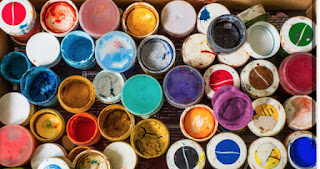December 11, 2024
Home painting requires knowing when to use each method. Picking the right paint is an important part of making that room look great. This page offers a wide variety of paint options. There are numerous paints available for sharing. Soon, you'll learn what paint you need and why. Understanding paint types and applications can help you choose the best product to improve the appearance and durability of different areas. Knowing this, you can choose the paint that best suits your home's style and needs.
Selecting the ideal paint type for a specific room can be even more challenging than choosing the colour you like. We will review all the different types of paint and how to pick the right type of paint for that room.
 |
| What colour do I use? |
Different types of Paint
- Interior: Use this type of paint on interior surfaces. It is often less durable than exterior paint and is susceptible to weather and UV damage. This means that while interior paint is designed for indoor use and may be easier to apply, it does not hold up as well against harsh conditions like sunlight and moisture compared to exterior paint. Thus, choosing the right paint for the environment is crucial.
- Exterior: surfaces are the intended application for this paint. It lasts longer than interior paint and is resistant to weather, UV damage, and fading. Using exterior paint ensures that surfaces exposed to the elements remain protected and vibrant over time. This choice is essential for maintaining the integrity and appearance of outdoor structures.
Paint Finishes:
- Flat: This finish is devoid of shine and effectively conceals surface imperfections.
- Eggshell: This finish has a slight sheen and is simple to clean.
- Satin: This finish has a medium sheen and is durable and simple to clean.
- Semi-gloss: This finish has a high sheen and is very durable and simple to clean.
- Gloss: This finish has the highest sheen and is very durable and simple to clean.
Conculision:
Select the proper paint finishes for the beauty as well as the performance of a space. Flat finishes provide a smooth, matte surface that helps mask surface imperfections in spaces that want an impermeable appearance. Then you go to an eggshell finish; there’s some sheen to it, some visual interest, and it’s also simple to clean—it's perfect for moderate-traffic areas. Satin finishes, on the other hand, strike a balance between aesthetic appeal and durability, offering a medium sheen that combines a pleasing elegance with sufficient resistance to daily wear and tear.
Finally, semi-gloss finishes add a designer touch with their bright reflection but are still simple to maintain and extremely durable, meaning they're the perfect choice for high-traffic areas or spaces that require regular cleaning. Having the option to compare the pros and cons of each system allows a homeowner to select what works best for them, resulting in an aesthetically pleasing end result that does not sacrifice practical attributes—providing desirable living quarters for many generations to come.
I really hope this info helps you get a better grasp on the different types of paint! If you have any questions, feel free to ask!
Regards,





